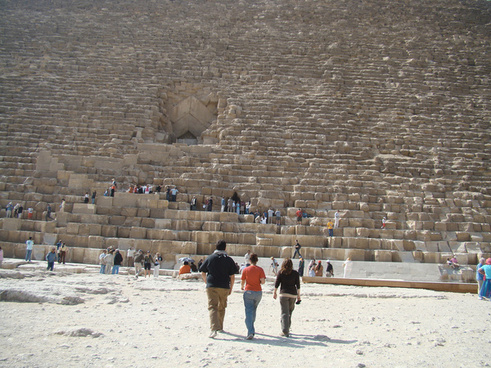Egypt – An Ancient Civilisation : The River of Life

The river Nile is the most
important geographical feature* of Egypt 6,600 km . In Egypt 1,100 km .
In the summer, after heavy tropical rains in the Upper
Nile Basin
(East Africa ), the river would swell. The
floods would reach Egypt Nile flooding
farming became possible in the dry and hot country on a strip of land from 6 to
20 km
wide. To make the best use of the water the people had learned to build dykes*
and canals. In catch basins the water could be kept for about forty days before
it ran off. To raise water from the river to the canal and from lower to higher
canals people used various means, such as the shadoof. Herodotus* was right
when he referred to Egypt as
a gift of the Nile . The flooding and the
watering of the fields in general allowed great harvests. The surplus production
of food, i.e. a production that is higher than actually needed, made it
possible that not everybody had to work in the fields.
Some people could for
example practice a craft, e. g. making pots (a potter) or be employed in
service. For farming the people would use wooden ploughs*, drawn by oxen. When
the soft soil had been turned, seed* was scattered* onto the fields. Then
animals, goats* and sheep, would trample it into the ground. Apart from being
important for farming the Nile was also the
waterway for transport, as there was no real road system. Then the river was
useful because of its fish. So you would see fishermen in their boats made of
papyrus. This plant was also used to make paper. But you would not only find
fish in the river, but also crocodiles and hippos*. Crocodiles were
life-threatening and hippos were disliked very much as they would run into the
fields and trample the plants.
The Egyptians depended very much on the Nile flooding. So each year they would watch out for
signs of the water rising. By carefully watching the regular flooding, which
roughly happened in an interval of 365 days, people developed a natural
calendar. Though not quite accurate this calendar was still comparatively the
best one in the ancient world.
The ‘Great House’ and the ‘Eternal* Home’
The word ‘pharaoh’ was used in
the Old Testament. It comes from Old Egyptian ‘pere’o’, which means ‘great
house’ or ‘royal palace’. As a pharaoh was thought to be godlike, his personal
name was much too holy with which to address him. In the course of time
‘pharaoh’ became a word for king and was used the same in modern times the
White House is used for the US Government. As a pharaoh was the king of Upper
and Lower Egypt he wore two crowns, a white one for Upper Egypt and a red one for
Lower Egypt . The royal symbols were a crook*
which it looked like a shepherd’s staff and a flail*. The pharaoh’s most
important duty was to win the support of the gods for his country and himself,
so he looked after all important religious festivals himself. He was the head
of the government; he made laws, he decided what was right or wrong and led the
army. Ordinary people, who had the honour to be received by him, had to
approach him in a very respectful manner. They had to kneel down before they were
allowed to speak to him.
As the Egyptians depended so much on the
Nile it was an absolute necessity to have an excellent organisation for all the
work in connection with the Nile flooding. To
control all this, the pharaoh was helped by a lot of people. His chief helpers
were two viziers*. The vizier had to see that the pharaoh’s orders were carried
out and he had to keep him informed. One of the vizier’s main duties was to
control the archives, the place where all important documents, such as royal
decrees (orders), were kept, so it was possible to check what people had to
hand in as taxes. The vizier also kept close contact with the local governors
of the districts. Such contacts would also stop them from becoming a threat to
the pharaoh’s position.
Below the viziers was the large group of
royal scribes (writers). Other scribes worked in temples or private estates*.
They had to control orders and did all the record keeping. They recorded nearly
everything, especially how many taxes people had to pay. They wrote reports on
the progress of temples or pyramids the pharaoh was building, and they were the
authors of historical texts and other documents. As there was only a very small
number of people who were able to read and write, ordinary people needed the service
of a scribe if they wanted to have something written or read out to them. The
importance of the scribe and the high opinion people had of him is shown by the
fact that he was often the subject in ancient Egyptian art.
Later, when the pyramid was finished, the
ramp was taken away. After the pharaoh’s death his coffin was moved inside and
the entrance blocked and hidden.











Post a Comment